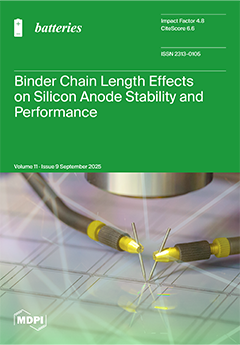All-solid-state lithium batteries (ASSLBs) employing Li-rich layered oxide (LLO) cathodes are regarded as promising next-generation energy storage systems owing to their outstanding energy density and intrinsic safety. Polymer-in-salt solid electrolytes (PISSEs) offer advantages such as high room-temperature ionic conductivity, enhanced Li anode interfacial
[...] Read more.
All-solid-state lithium batteries (ASSLBs) employing Li-rich layered oxide (LLO) cathodes are regarded as promising next-generation energy storage systems owing to their outstanding energy density and intrinsic safety. Polymer-in-salt solid electrolytes (PISSEs) offer advantages such as high room-temperature ionic conductivity, enhanced Li anode interfacial compatibility, and low processing costs; however, their practical deployment is hindered by poor oxidative stability especially under high-voltage conditions. In this study, we report the rational design of a bilayer electrolyte architecture featuring an in situ solidified LiClO
4-doped succinonitrile (LiClO
4–SN) plastic–crystal interlayer between a Li
1.2Mn
0.6Ni
0.2O
2 (LMNO) cathode and a poly (vinylidene fluoride-co-hexafluoropropylene) (PVDF-HFP)-based PISSE. This PISSE/SN–LiClO
4 configuration exhibits a wide electrochemical stability window up to 4.7 V vs. Li
+/Li and delivers a high ionic conductivity of 5.68 × 10
−4 S cm
−1 at 25 °C. The solidified LiClO
4-SN layer serves as an effective physical barrier, shielding the PVDF-HFP matrix from direct interfacial contact with LMNO and thereby suppressing its oxidative decomposition at elevated potentials. As a result, the bilayer polymer-based cells with the LMNO cathode demonstrate an initial discharge capacity of ∼206 mAh g
−1 at 0.05 C and exhibit good cycling stability with 85.7% capacity retention after 100 cycles at 0.5 C under a high cut-off voltage of 4.6 V. This work not only provides a promising strategy to enhance the compatibility of PVDF-HFP-based electrolytes with high-voltage cathodes through the facile in situ solidification of plastic interlayers but also promotes the application of LMNO cathode material in high-energy ASSLBs.
Full article





